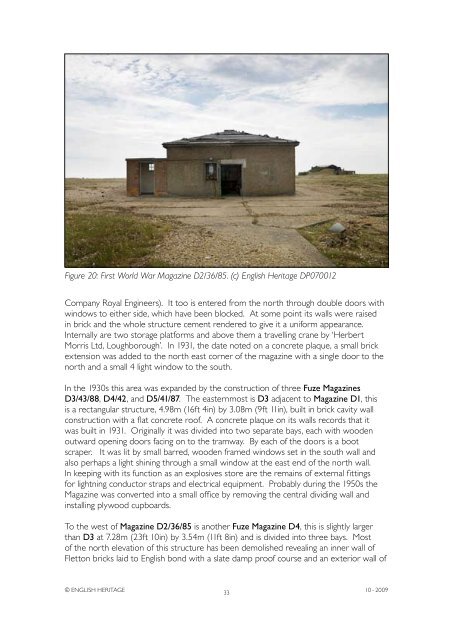Atomic Weapons Research Establishment. Orford ... - English Heritage
Atomic Weapons Research Establishment. Orford ... - English Heritage
Atomic Weapons Research Establishment. Orford ... - English Heritage
You also want an ePaper? Increase the reach of your titles
YUMPU automatically turns print PDFs into web optimized ePapers that Google loves.
Figure 20: First World War Magazine D2/36/85. (c) <strong>English</strong> <strong>Heritage</strong> DP070012<br />
Company Royal Engineers). It too is entered from the north through double doors with<br />
windows to either side, which have been blocked. At some point its walls were raised<br />
in brick and the whole structure cement rendered to give it a uniform appearance.<br />
Internally are two storage platforms and above them a travelling crane by ‘Herbert<br />
Morris Ltd, Loughborough’. In 1931, the date noted on a concrete plaque, a small brick<br />
extension was added to the north east corner of the magazine with a single door to the<br />
north and a small 4 light window to the south.<br />
In the 1930s this area was expanded by the construction of three Fuze Magazines<br />
D3/43/88, D4/42, and D5/41/87. The easternmost is D3 adjacent to Magazine D1, this<br />
is a rectangular structure, 4.98m (16ft 4in) by 3.08m (9ft 11in), built in brick cavity wall<br />
construction with a flat concrete roof. A concrete plaque on its walls records that it<br />
was built in 1931. Originally it was divided into two separate bays, each with wooden<br />
outward opening doors facing on to the tramway. By each of the doors is a boot<br />
scraper. It was lit by small barred, wooden framed windows set in the south wall and<br />
also perhaps a light shining through a small window at the east end of the north wall.<br />
In keeping with its function as an explosives store are the remains of external fittings<br />
for lightning conductor straps and electrical equipment. Probably during the 1950s the<br />
Magazine was converted into a small office by removing the central dividing wall and<br />
installing plywood cupboards.<br />
To the west of Magazine D2/36/85 is another Fuze Magazine D4, this is slightly larger<br />
than D3 at 7.28m (23ft 10in) by 3.54m (11ft 8in) and is divided into three bays. Most<br />
of the north elevation of this structure has been demolished revealing an inner wall of<br />
Fletton bricks laid to <strong>English</strong> bond with a slate damp proof course and an exterior wall of<br />
© ENGLISH HERITAGE<br />
33<br />
10 - 2009

















